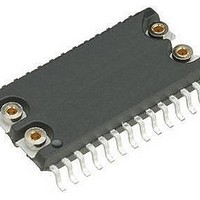M48T86MH1 STMicroelectronics, M48T86MH1 Datasheet - Page 17

M48T86MH1
Manufacturer Part Number
M48T86MH1
Description
Real Time Clock USE 511-M48T86MH1E
Manufacturer
STMicroelectronics
Datasheet
1.M48T86MH1.pdf
(36 pages)
Specifications of M48T86MH1
Function
Clock, Calendar, Interrupt, Alarm
Rtc Memory Size
128 B
Supply Voltage (max)
5.5 V
Supply Voltage (min)
4.5 V
Maximum Operating Temperature
+ 70 C
Minimum Operating Temperature
0 C
Mounting Style
SMD/SMT
Rtc Bus Interface
Multiplexed
Package / Case
SO-28
Time Format
HH:MM:SS, Binary
Date Format
DW:DM:M:Y, Binary
Lead Free Status / RoHS Status
Lead free / RoHS Compliant
Available stocks
Company
Part Number
Manufacturer
Quantity
Price
Company:
Part Number:
M48T86MH1
Manufacturer:
CARTYS
Quantity:
2 585
Part Number:
M48T86MH1
Manufacturer:
ST
Quantity:
20 000
M48T86
3.5
3.6
3.7
3.8
Alarm interrupt
The alarm interrupt provides the system processor with an interrupt when a match is made
between the RTC's hours, minutes, and seconds bytes and the corresponding alarm bytes.
The three alarm bytes can be used in two ways. First, when the alarm time is written in the
appropriate hours, minutes, and seconds alarm locations, the alarm interrupt is initiated at
the specified time each day if the Alarm Interrupt Enable bit (Register B; Bit 5) is high. The
second use is to insert a “Don't care” state in one or more of the three alarm bytes. The
“Don't care” code is any hexadecimal value from C0 to FF. The two most significant bits of
each byte set the “Don't care” condition when at logic '1.' An alarm will be generated each
hour when the “Don't care” is are set in the hours byte. Similarly, an alarm is generated
every minute with “Don't care” codes in the hour and minute alarm bytes. The “Don't care”
codes in all three alarm bytes create an interrupt every second.
Update cycle interrupt
After each update cycle, the Update Cycle Ended Flag bit (UF) (Register C; Bit 4) is set to a
'1.' If the Update Interrupt Enable bit (UIE) (Register B; Bit 4) is set to a '1,' and the SET bit
(Register B; Bit 7) is a '0,' then an interrupt request is generated at the end of each update
cycle.
Oscillator control bits
When the M48T86 is shipped from the factory the internal oscillator is turned off. This
feature prevents the lithium energy cell from being discharged until it is installed in a system.
A pattern of “010” in Bits 4-6 of Register A will turn the oscillator on and enable the
countdown chain. A pattern of “11X” will turn the oscillator on, but holds the countdown
chain of the oscillator in reset. All other combinations of Bits 4-6 keep the oscillator off.
Update cycle
The M48T86 executes an update cycle once per second regardless of the SET bit (Register
B; Bit 7). When the SET bit is asserted, the user copy of the double buffered time, calendar,
and alarm bytes is frozen and will not update as the time increments. However, the time
countdown chain continues to update the internal copy of the buffer. This feature allows
accurate time to be maintained, independent of reading and writing the time, calendar, and
alarm buffers. This also guarantees that the time and calendar information will be
consistent. The update cycle also compares each alarm byte with the corresponding time
byte and issues an alarm if a match or if a “Don't care” code is present in all three positions.
There are three methods of accessing the real time clock that will avoid any possibility of
obtaining inconsistent time and calendar data. The first method uses the update-ended
interrupt. If enabled, an interrupt occurs after every update cycle which indicates that over
999ms are available to read valid time and date information. If this interrupt is used, the
IRQF Bit (Register C; Bit 7) should be cleared before leaving the interrupt routine.
A second method uses the Update-In-Progress (UIP) bit (Register A; Bit 7) to determine if
the update cycle is in progress. The UIP bit will pulse once per second. After the UIP bit
goes high, the update transfer occurs 244 µs later. If a low is read on the UIP bit, the user
has at least 244 µs before the time/calendar data will be changed. Therefore, the user
Clock operations
17/36













